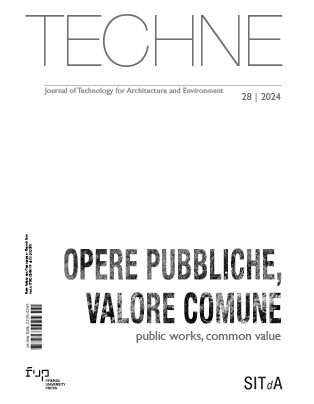Coastal Greenways in Italy: an Environmental Infrastructure Awaiting an Integrated Territorial Project
Published 2024-10-29
Keywords
- Greenway,
- Environmental infrastructure,
- Landscape,
- Fragility,
- Territory
How to Cite
Copyright (c) 2024 Antonio Alberto Clemente

This work is licensed under a Creative Commons Attribution 4.0 International License.
Abstract
Greenways, territorial fragilities, and landscape are distinct themes. This is evident from the comparison of projects for the five coastal greenways already implemented in Italy on abandoned railway tracks. The aim is to overcome this separation by envisioning the greenway as an environmental infrastructure that serves as a catalyst for a broader territorial project, as achieved by San Rafael, Melbourne, and Enschede. The perspective is to utilise rain gardens, bioswales, and stormwater tree trenches to transform the greenway into a permeable body where existing and planned vegetation provides opportunities to rethink open space in terms of ecosystem services. This new design concept is also beneficial for the fourteen greenways scheduled for future implementation.
Downloads
References
- Angrilli, M. (1999), “Greenways”, Urbanistica, n. 113, INU, Roma, pp. 92-97.
- Bionic Team, (2018), Elevate San Rafael. Resilient by design. Bay area challenge, Lakewood, p. 9. Available at: http://www.resilientbayarea.org/elevate-san-rafael (Accessed on 05/14/2024).
- Bryant, M.M. (2004), “Urban landscape conservation and the role of ecological greenways at local and metropolitan scales”, Landscape and Urban Planning, Vol. 76, p. 29. Available at: https://doi.org/10.1016/j.landurbplan.2004.09.029 (Accessed on 05/14/2024). DOI: https://doi.org/10.1016/j.landurbplan.2004.09.029
- City of Melbourne (2013), La Trobe Street green bicycle lane. Available at: https://urbanwater.melbourne.vic.gov.au/projects/greening-projects/la-trobe-street-bicycle-lane/ (Accessed on 05/14/2024).
- Coppola, E. (2021), “Il territorio attraversato: il ripristino delle linee ferroviarie dismesse come progetto di paesaggio”, in Coppola, E., D’Avino, M. and Moccia, F.D. (Ed.), Riciclo dei trasporti scartati e dei paesaggi dimenticati, CLEAN, Napoli, pp. 14-38.
- Dallatorre, G. (2022), “Camminare come progetto: coreografie di paesaggio attraverso ferrovie dismesse”, Ri-Vista. Research for Landscape Architecture, Vol. 20(1), pp. 238-263. Available at: https://doi.org/10.36253/rv-12533 (Accessed on 05/14/2024). DOI: https://doi.org/10.36253/rv-12533
- Donati, A. and Senes, G. (2022), “La creazione dell’Atlante della mobilità dolce in Italia” in Belloni, E. and Maggi, S. (Ed.), Verso una mobilità più sostenibile, Franco Angeli, Milano, pp. 44-57.
- Flink, C.A. (2020), The Greenway Imperative. Connecting Communities and Landscapes for a Sustainable Future, University of Florida Press, Gainesville, p. 15.
- Ferrovie dello Stato Italiane, (2022a), Atlante delle greenways su linee FS. Dal disuso al riuso, Roma. Available at: https://www.rfi.it/content/dam/rfi/news-e-media/pubblicazioni/atlante-greenways-2022/RFI%20ATLANTE%203%20GREENWAYS%202022%2006_12%20b8%20WEB%20D.pdf (Accessed on 05/14/2024).
- Ferrovie dello Stato Italiane, (2022b), Atlante delle linee ferroviarie dismesse, Roma. Available at: https://www.rfi.it/content/dam/rfi/news-e-media/pubblicazioni/atlante-2022/RFI%20ATLANTE%201%20LINEE%20DISMESSE%2023_05_22%20WEB%20D.pdf (Accessed on 05/14/2024).
- Gemeente Enschede (2022), Water and Climate Adaptation Plan 2022-2026. Available at: https://groenblauwenschede.ireporting.nl (Accessed on 05/14/2024).
- Istituto Superiore per la Protezione e la Ricerca Ambientale, (2020), XV Rapporto Qualità dell’ambiente urbano. Suolo e territorio, Rome. Available at: https://www.snpambiente.it/wp-content/uploads/2020/09/Cap.-2.pdf (Accessed on 05/14/2024).
- Kipar, A. (2003), “L’infrastruttura nel paesaggio, una sfida per l’ambiente” in Ponticelli L. e Micheletti, C. (Ed.), Nuove infrastrutture per nuovi paesaggi, Skira, Milano, p. 135.
- Legambiente (2023), Rapporto spiagge. La situazione e i cambiamenti in corso nelle aree costiere italiane, Roma. Available at: https://www.legambiente.it/rapporti-e-osservatori/rapporto-spiagge/ (Accessed on 05/14/2024).
- Meloni, I. and Palma, R. (Ed.), (2022), Paesaggio con biciclette. Piccola ontologia illustrata per il progetto delle ciclovie di lunga percorrenza, Accademia University Press, Torino.
- Parkin, J. (Ed.), (2012), Cycling and Sustainability, Emerald Publishing, Bingley. DOI: https://doi.org/10.1108/S2044-9941(2012)1
- Pinna, F. and Saiu, V. (2021), “Greenways as Integrated Systems: A Proposal for Planning and Design Guidelines Based on Case Studies Evaluation”, Sustainability, Vol. 13, 11232, p. 1. Available at: https://doi.org/10.3390/su132011232 (Accessed on 05/14/2024). DOI: https://doi.org/10.3390/su132011232
- Rovelli, R. (2019), “Da ferrovie dismesse a greenways: uno sguardo alla situazione italiana”, in Ferrovie dello Stato Italiane, Atlante di viaggio lungo le ferrovie dismesse, Roma, p. 11. Available at:
- https://www.fsitaliane.it/content/dam/fsitaliane/Documents/impegno/per-ambiente/progetti/RFI_2017_11_10_Atlante_viaggio_ferrovie_dismesse.pdf (Accessed on 05/14/2024).
- Rovelli, R. (2022), “Il riutilizzo delle ferrovie dismesse come greenways in Italia”, in Ferrovie dello Stato Italiane, Atlante delle greenways, op. cit., p. 53.
- Searns, R.M. (1995), “The evolution of greenways as an adaptive urban landscape form”, Landscapeand Urban Planning, Vol. 33, p. 79. Available at: https://doi.org/10.1016/0169-2046(94)02014-7 (Accessed on 05/14/2024). DOI: https://doi.org/10.1016/0169-2046(94)02014-7
- Stavrides, S. (2016), Common Space: The City as Commons, Zed Books, London. DOI: https://doi.org/10.5040/9781350219267
- Tira, M. and Zazzi, M. (2007), Pianificare le reti ciclabili territoriali, Gangemi, Roma.






